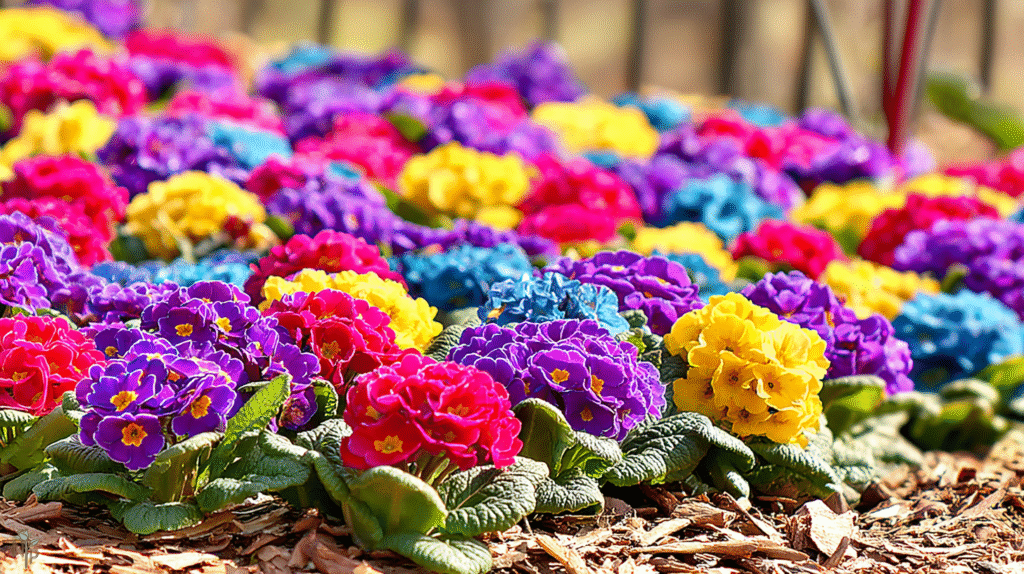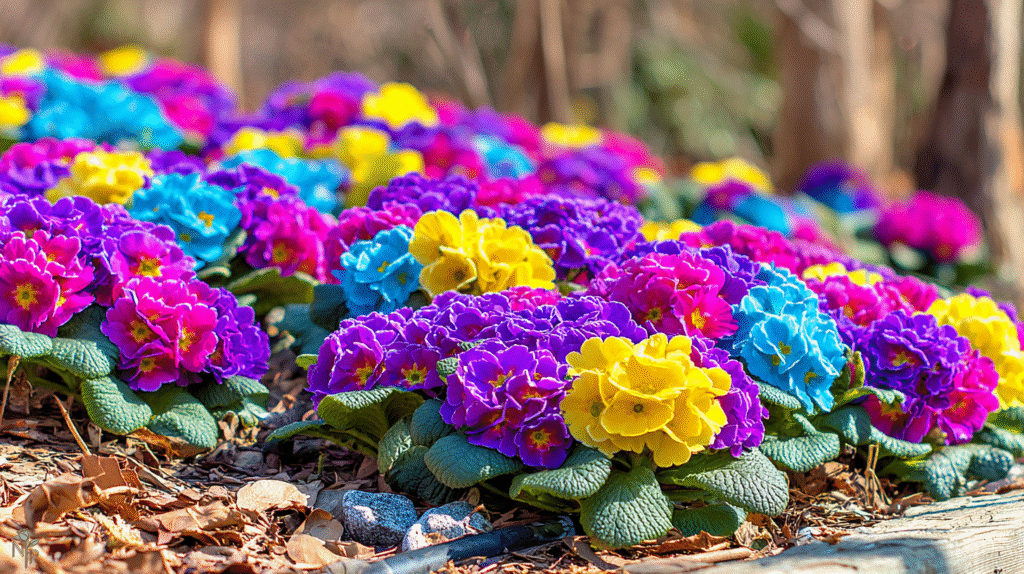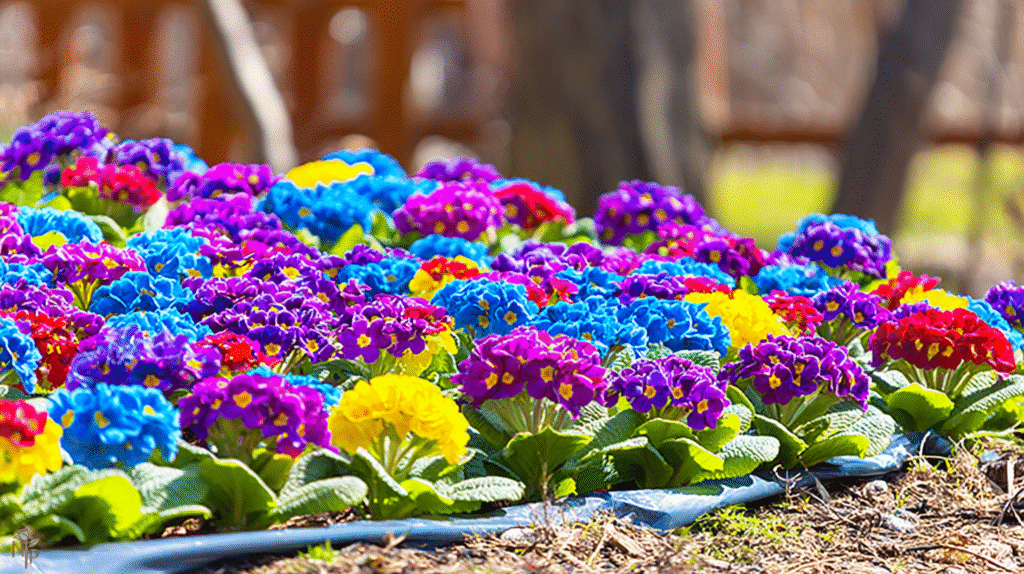My first primroses lasted exactly five days. Bought six gorgeous plants from the grocery store in February, planted them in my garden, and watched them melt into sad, brown mush by the weekend. Turns out those greenhouse primroses and actual outdoor primroses have very different opinions about life.
Four years and probably thirty dead primroses later (I’m nothing if not persistent), I now have patches that come back every spring like clockwork. Some are going on year three, spreading into thick carpets of color while my neighbors ask what my secret is. The secret? I finally stopped treating them like petunias and started treating them like the woodland weirdos they actually are.
The Soil Situation That Changes Everything
For two years, I kept planting primroses in my regular garden soil – the same stuff where my marigolds and zinnias thrived. They’d look okay for a week, then slowly turn yellow and die. Every. Single. Time.
Here’s what nobody tells you: primroses want soil that would kill most other flowers. They want it rich, moisture-retentive, and slightly acidic. My regular garden soil was sandy, fast-draining, and alkaline. Basically primrose hell.
The mix that finally worked:
- 40% regular topsoil (the cheap bagged stuff)
- 30% compost (homemade or bagged)
- 20% peat moss (or coco coir if you’re anti-peat)
- 10% perlite (seems wrong for moisture lovers but trust me)
This mix holds water like a sponge but doesn’t get waterlogged. The perlite keeps it from compacting into concrete when it dries. First time I used this mix, my primroses actually survived summer. Revolutionary.
The pH drama nobody mentions: Primroses want soil between 6.0 and 6.5 pH. Mine was 7.5. No wonder they kept dying. Bought a $7 pH test kit from the hardware store, confirmed my soil was way too alkaline, added sulfur to lower it. Took three months to get it right, but the primroses that year? Spectacular.
If your primroses get yellow leaves with green veins, that’s usually pH problems. The nutrients are there but the plant can’t access them because the pH is wrong. Fixed this with aluminum sulfate – works faster than regular sulfur but easy to overdo.

Watering: More Complicated Than You’d Think
Everyone says primroses like “consistently moist soil.” What the hell does that mean? Moist like a wrung-out sponge? Moist like cake? Moist like a swamp?
After killing many primroses both ways, here’s what consistently moist actually means: stick your finger in the soil. Should feel like a damp sponge that’s been squeezed but not completely wrung out. Never soggy, never dry, always that perfect in-between that’s annoying to maintain.
Spring watering (March-May): This is when they’re blooming and actively growing. I water every 2-3 days if it hasn’t rained. But here’s the trick – water the soil, not the plant. Water on the flowers causes them to rot. Water on the leaves causes fungal spots. I use a watering can with the rose removed and water directly at the base.
Summer watering (June-August): The death zone. Primroses hate hot, dry weather. I water daily during heat waves, sometimes twice if it’s over 85°F. Added thick mulch around them (3 inches of shredded leaves) which helped enormously. The ones in more shade need less water than the ones getting afternoon sun.
Lost an entire bed one July when I went on vacation for a week. Came back to crispy brown shells. Now I have a soaker hose on a timer for summer. Game changer.
Fall/Winter watering: Basically just let rain handle it unless we’re in a dry spell. Primroses are tougher in cool weather. Actually, too much water in winter will rot them faster than summer drought will kill them.
Location Mistakes That Took Years to Figure Out
Planted my first primroses in full sun because the tag said “full sun to part shade.” The tag lied. Or maybe it was written by someone in Scotland where “full sun” means something very different than here.
Primroses want morning sun and afternoon shade, or dappled shade all day. The ones I planted under my dogwood tree? Thriving for three years now. The ones in the “full sun” flower bed? Dead by June every year until I gave up.
My current primrose locations that work:
- North side of the house (gets morning sun only)
- Under deciduous trees (sun in spring before leaves come out, shade in summer)
- East side of the shed (morning sun, afternoon shade)
- Along the woodland edge (dappled shade all day)
The ones that get the most afternoon shade need the least summer watering. The ones with more sun need daily water and still look stressed by August.
Mulch: The Secret Weapon
Didn’t mulch my first year. Primroses died. Mulched with wood chips the second year. Primroses died slower. Third year, discovered the magic of leaf mulch.
Shredded leaves are primrose gold. They hold moisture, break down into the slightly acidic organic matter primroses love, and keep soil temperature stable. I collect bags of leaves from neighbors in fall, shred them with the mower, and pile them 3 inches thick around primroses.
Wood mulch works but seems to repel water when it dries out. Grass clippings got slimy and caused crown rot. Pine needles worked great but I don’t have enough pine trees. Leaf mulch is free, plentiful, and primroses love it.
Feeding Without Killing Them
Primroses are hungry plants but sensitive to fertilizer burn. Learned this when I used regular 10-10-10 fertilizer and burned the hell out of them. Brown leaf edges, stopped blooming, general sadness.
Now I use:
- Early spring (as shoots emerge): Scratched-in compost around each plant
- During blooming: Liquid fertilizer at quarter strength every two weeks
- After blooming: One dose of slow-release, low-nitrogen fertilizer
- Fall: More compost, preparing for winter
The liquid fertilizer I use is fish emulsion. Stinks to high heaven but primroses go crazy for it. Just dilute it way more than the package says. I do 1 tablespoon per gallon instead of the recommended 3 tablespoons.

Problems That Almost Made Me Give Up
Crown rot: Lost six primroses to this before figuring it out. Water sitting in the crown (center) of the plant causes rot. Now I water the soil around the plant, never the center. Also, don’t bury the crown when planting – keep it at soil level.
Spider mites: Hot, dry weather brings these bastards. Tiny webs, stippled leaves, general decline. Spray with water every few days to knock them off. Insecticidal soap if desperate. Keeping plants well-watered helps prevent them.
Sudden death in summer: Sometimes primroses just peace out when it gets hot. Even with perfect care. Now I treat them as semi-annuals – if they come back, great. If not, I replant in fall. Takes pressure off trying to keep them alive through August.
Aphids: These jerks love new primrose growth. Blast them off with the hose or squish them with fingers (gross but effective). Ladybugs help if you can get them to stick around.
The Varieties That Actually Survive
After trying every primrose type available, these are the winners:
Primula vulgaris (English primrose): Toughest of the bunch. Comes back every year, spreads nicely, handles my mistakes. The yellow ones seem tougher than other colors.
Primula japonica (Japanese primrose): Loves wet spots. Planted these near the downspout where everything else drowned. Three years later, they’re huge and self-seeding everywhere.
Primula denticulata (Drumstick primrose): Weird-looking but bulletproof. Survived the spot where I killed everything else. Blooms earlier than others, done before real heat hits.
The grocery store ones (Primula acaulis): Pretty but usually treated as annuals here. Sometimes they surprise you and come back, but don’t count on it.
My Current Routine That Works
Spring: Remove winter mulch, add compost, start watering as growth appears. Feed every two weeks during blooming.
Summer: Water daily if needed, maintain thick mulch, accept that some might die. Deadhead spent flowers to prevent seeding (weakens the plants).
Fall: Add fresh leaf mulch, plant new primroses, divide overcrowded clumps.
Winter: Leave them alone. Maybe add extra mulch if we’re having a severe cold snap.
The biggest lesson? Primroses want to grow in conditions that would kill most flowers – moist, rich, slightly acidic soil with cool roots and protection from afternoon sun. Give them that and they’re surprisingly tough. Fight their nature and you’ll be replanting every year.
Now I’ve got primroses that my garden club friends envy, which is hilarious considering how many I killed getting here. But every spring when they burst into bloom while everything else is still dormant, all those dead plants feel worth it.







